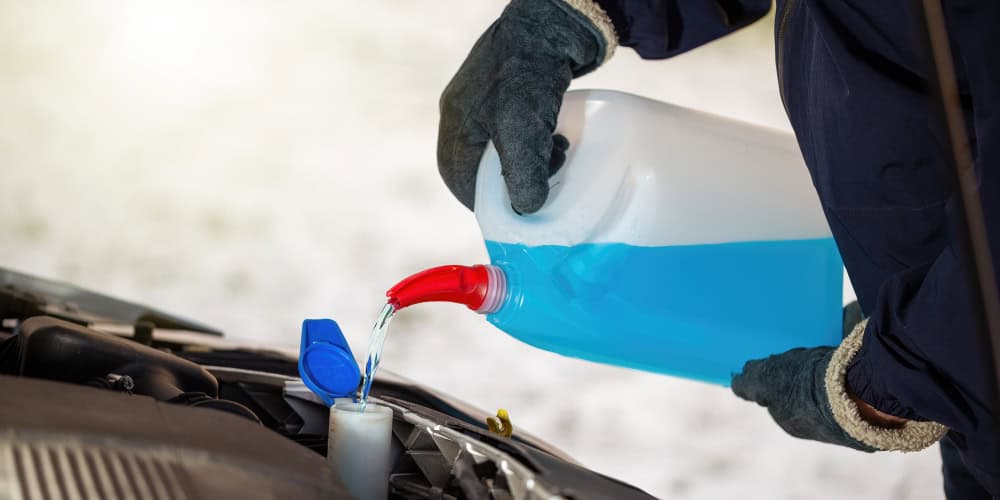Antifreeze Poisoning in Dogs: Risks, Symptoms, and Prevention
This is one of the most common forms of poisoning in dogs. Antifreeze, used as a coolant in vehicles, is a leading source of ethylene glycol, a substance highly toxic to dogs. This clear, odorless, and sometimes sweet-tasting liquid can be dangerously attractive to animals, especially when it pools in puddles beneath or around vehicles. It’s crucial to know that even a tiny amount can be lethal to a dog.

How Can Dogs Be Exposed to Antifreeze?
Dogs are particularly at risk because they can easily come into contact with antifreeze when it leaks from cars and forms puddles in garages or on the road. They may drink from these puddles or step in them, later licking the antifreeze off their paws. Ethylene glycol is rapidly absorbed into their system, and even a small amount can be fatal—less than half a teaspoon per kilogram of body weight can be deadly.
Antifreeze poisoning isn’t just dangerous for dogs; other pets, such as cats, are also susceptible. Additionally, ethylene glycol is toxic to humans, which is why it’s vital to always store antifreeze in a secure location, out of reach of both pets and children.
How Antifreeze Poisoning Affects a Dog’s Body
When a dog ingests ethylene glycol, the toxin is quickly absorbed from the stomach and metabolized by the liver into substances that are especially harmful to the kidneys. The poisoning can cause severe damage to the dog’s digestive system, liver, brain, and kidneys. Antifreeze poisoning in dogs manifests in three stages, each with distinct symptoms that pet owners should be aware of.
The Three Stages of Antifreeze Poisoning
- Stage One (30 minutes – 12 hours): In the first stage, ethylene glycol acts similarly to alcohol in the dog’s body. The dog may exhibit signs of intoxication, such as confusion, lack of coordination, tremors, stumbling, and sluggish reflexes. Common symptoms include vomiting, increased thirst (polydipsia), and frequent urination (polyuria).
- Stage Two (12 – 24 hours): In the second stage, the dog’s condition may seem to improve, and they may appear to return to normal behavior. However, this calm can be deceptive, as the toxins continue to work internally. Although the dog may seem fine, severe organ damage, particularly to the kidneys and liver, is occurring. Increased breathing rates might also be present, but pet owners may not notice this subtle sign.
- Stage Three (36 – 72 hours): In the final stage, the toxic byproducts of ethylene glycol accumulate in sufficient quantities to cause acute kidney failure. This can progress to seizures, coma, and eventually death if the dog does not receive prompt medical treatment.
What to Do if Your Dog Ingests Antifreeze
If you suspect that your dog has consumed antifreeze, seek veterinary care immediately. Ethylene glycol is rapidly absorbed, and toxic compounds start to accumulate almost immediately, so any delay increases the risk of a fatal outcome. Because antifreeze poisoning progresses quickly, the best chance for survival is if the dog receives treatment within the first five hours.
Diagnosing antifreeze poisoning in dogs can be difficult because pet owners may not witness their dog drinking it. The veterinarian will start with a physical exam and may recommend blood tests. However, ethylene glycol doesn’t always show up immediately in the blood because it takes time for toxic substances to form. That’s why, if you have even the slightest suspicion, it’s critical to get your dog to the vet right away.
How is Antifreeze Poisoning Treated?
Treating antifreeze poisoning in dogs is extremely time-sensitive. One of the primary goals is to prevent further metabolism of the toxin into more harmful substances. Vets typically use 4-methylpyrazole (4-MP, fomepizole), which blocks the breakdown of ethylene glycol into toxic compounds. This treatment is most effective within the first five hours after ingestion, as the toxins have not yet caused irreversible damage during this window.

Ethanol was also previously used as an antidote because it inhibits the breakdown of ethylene glycol. However, ethanol has significant side effects, including further depression of the central nervous system, so it is now less commonly used. 4-MP is preferred due to its fewer side effects and similar effectiveness.
In severe cases, when the poisoning has led to kidney failure, dialysis may be used to remove the toxins from the bloodstream. However, this treatment is expensive and not widely available at all veterinary clinics. Unfortunately, once kidney failure has progressed, the prognosis is generally poor, even with dialysis.
How to Prevent it
The best way to prevent antifreeze poisoning in dogs is through vigilance and education. Here are some helpful tips to keep your dog safe:
- Store antifreeze safely: Always store antifreeze in a sealed, secure container that is out of reach of pets and children.
- Clean up spills immediately: If antifreeze spills, clean it up right away, and make sure no animals can access the area.
- Be aware of your surroundings: Check for suspicious puddles in garages, driveways, or streets, and keep your dog away from them.
- Choose pet-safe antifreeze: Some antifreeze products now contain propylene glycol, which is less toxic to animals. If possible, opt for these products instead.
By staying alert and keeping antifreeze and other hazardous substances out of reach, you can significantly reduce the risk of antifreeze poisoning and keep your pet safe.
For more articles and tips on living with dogs, canine sports, and various dog diseases topics, visit our website!

